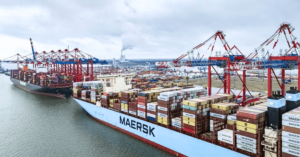
World’s First Commercial Sailing RORO Ship Launched In Türkiye
February 1, 2025
Philippines Will Return U.S. Missile If China Stops Aggression In South China Sea
February 1, 2025

Maersk and Hapad Lloyd have officially launched their new long-term operational collaboration called the Gemini Cooperation. This collaboration will deliver a flexible and interconnected ocean network that will provide industry-leading schedule reliability of over 90% once fully phased in.
The first sailings under the Gemini Cooperation started on February 1, 2025, and the transition to the new network will take place gradually. Around 340 vessels will be phased in, with the complete transition expected by late May.
June will be the first full month of operation with all vessels sailing under the Gemini Cooperation schedules. During this phase, the vessels will be pulled out of the expiring agreements Maersk and Hapag Lloyd have with other carriers.
Johan Sigsgaard, Chief Product Officer of Ocean at Maersk, mentioned that the phase-in process has been carefully planned to ensure that customers experience a smooth transition. He added that the new network’s innovative design would offer increased reliability, flexibility and more competitive services.
The Gemini Cooperation network will focus on East/West trade routes and will include 29 mainline services. The network will also feature 28 intraregional shuttle services.
The cooperation will cover the following trades:
- Asia-US West Coast
- Asia-US East Coast
- Asia-Middle East
- Asia-Mediterranean
- Asia-North Europe
- Middle East-India-Europe
- Transatlantic
The Gemini Cooperation will combine the fleets of both companies, with around 290 vessels in total, offering a combined capacity of 3.4 million containers (TEU).
Maersk will deploy 60% of the vessels, while Hapag Lloyd will deploy 40%. The new network will offer flexible operations, allowing both companies to scale capacity based on customer demand outside of the network.
Rofl Habben Jansen, CEO of Hapag Lloyd, stated that the cooperation with Maersk will help boost the quality of services offered to customers. He also said that the partnership will help them decarbonise the shipping industry.
Meanwhile, Vincent Clerc, CEO of Maersk, described Hapag Lloyd as the ideal partner for their journey, adding that this cooperation will improve their integrated logistics offerings.
Both companies are committed to reducing emissions in their fleets, with Maersk targeting net-zero emissions by 2040 and Hapag-Lloyd aiming for net-zero emissions by 2045.
Maersk has already launched the world’s first container vessel capable of running on green methanol, with 24 more methanol-enabled vessels on order. The company owns about 700 vessels with a total capacity of over 4 million TEU.
On the other hand, Hapag Lloyd operates a fleet of 264 container ships with a total transport capacity of 2.0 million TEU. The company offers 113 liner services worldwide and ensures reliable connections between over 600 ports.
Along with its fleet, Hapag Lloyd holds stakes in 20 terminals across various regions including Europe, Latin America, the US, India and North Africa.
With the launch of Gemini Cooperation, Hapag Lloyd left THE Alliance in January 2025. Maersk and MSC’s 2M Alliance also ended in January 2025.
References: Maersk, Hapag Lloyd
Source: Maritime Shipping News


